
![]()
| back to main page |
|
| Die LIMUS Umwelttechnik
GmbH hat Ihre Geschäftstätigkeit aufgegeben. Wir von der PONDUS Verfahrenstechnik GmbH möchten Ihnen aber gern weiterhin mit Rat und Tat zur Seite stehen. |
 |
| Wir freuen uns über Ihren Besuch. Sie werden automatisch zu uns weitergeleitet. |
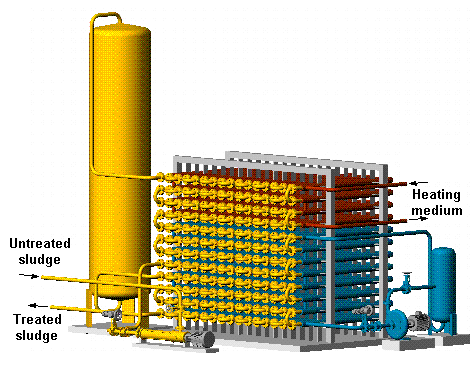
Fig. 1: Model of a plant for thermal disintegration of surplus
sludge
Organic sludges are disintegrated in such a manner that subsequent digestion is intensified, thereby not only boosting the gas yield but also diminishing the quantity of material that has to be disposed. Mechanical equipment such as high-pressure homogenisers and agitator bead mills, as well as ultrasonics, electro-shock, chemical and thermal processes, can be used for this purpose. It is obvious, to treat preferably surplus sludge in this manner because it resists anaerobic digestion, particularly with a low sludge loading.
Experience has shown that mechanical and electromechanical methods from the pharmaceutical industry are uneconomical in the case of sludge treatment on account of their high power consumption rates. Our moderate-thermal treatment process ensures more effective and economical cell disintegration. The process involves heating the sludge that is to be treated to a temperature of approx. 130°C and kept at this temperature for about 2 hours. The heat required for this purpose is then used to heat the digestion process.
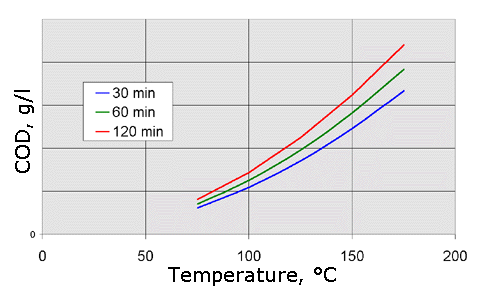
Fig. 2: Influence of temperature and residence time on
filtrate-COD.
Our own examinations, and those of others, Fig. 2, have shown that digestion is intensified with increasing temperature and residence time of disintegration. Optimal conditions are around 135°C and 2 h. At temperatures in surplus of 150°C the COD/BOD5 ratio in the filtrate slowly increases, thereby indicating the formation of hardly biodegradable substances.
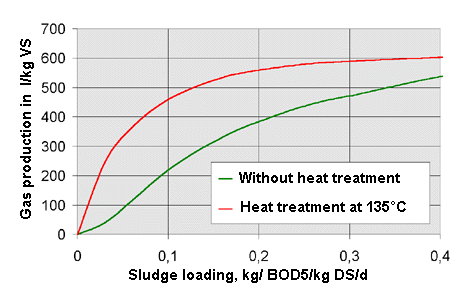
Fig. 3: Gas production from surplus sludge during a 20-day
digestion period according to Pinnekamp.
The additional decomposition of organic substances during subsequent digestion as a result of cell disintegration is particularly high with surplus sludges from activated sludge plants with the nowadays customary low sludge loading rates, Fig. 3. The gas volume can be doubled, even trebled, in this area. This is associated with a parallel reduction of the DS load.
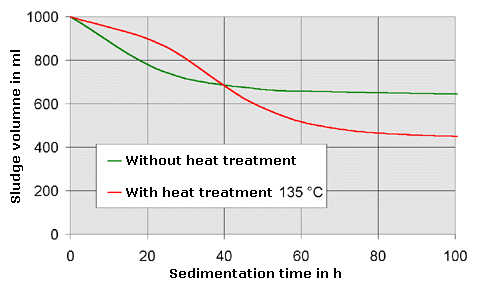
Fig. 4: Sedimentation behaviour of digested surplus sludge
Additional loading of the sewage treatment plant by substances such as COD, total-N and PO4-P, dissolved in the digestion water due to thermal treatment is negligible.
The dewatering characteristics of sludges are likewise influenced by cell disintegration and anaerobic after-treatment. The degree of dewaterage increases as the dewatering speed decreases. The destruction of the cells reduces the average particle size, but this is also the precondition to making cell water accessible for dewatering, Fig. 4.
A regenerative heat exchanger must be interposed between the treated and untreated sludge to ensure operating efficiency. If the exit temperature of the disintegrated sludge has been correctly set, then mixing with raw sludge will result in a temperature of around 37°C which is sufficient to ensure that subsequent mesophile digestion does not require any heat input. Two variant methods are available for heat recovery:
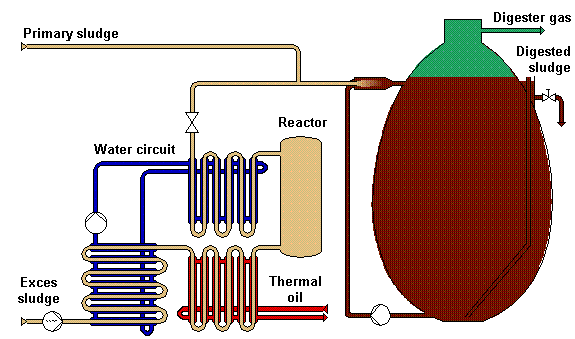
Fig. 5: Flow sheet of thermal cell
disintegration with indirect heat exchange
In the case of indirect heat exchange double pipe apparatus with an intermediate water-circuit, spiral heat exchangers or similar equipment are used that is not prone to clogging. Fig. 5 shows an example. The surplus sludge that is preheated in the first heat exchanger, raised to treatment temperature in the second heat exchanger, held in the reactor for the given residence time, and finally transferred to the third heat exchanger to cool down the sludge so that after mixing with primary sludge it has a temperature that is slightly above the customary digestion temperature. This mixture is transferred to the digestion circuit. On account of the danger of clogging in the external jacket, sludge only flows through the inner tube of the double-tube heat exchangers. The jacket side of the first and third heat exchanger is therefore connected to the hot-water circuit. Pressureless thermal oil is used in the second heat exchanger.
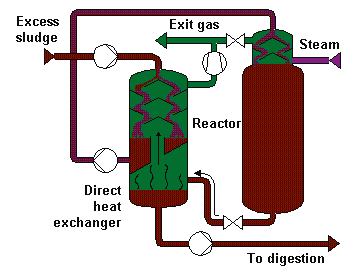
Fig. 6: The direct heat exchanger process
With direct heat exchange, Fig. 6, the sludge is preheated by steam in the upper section of a direct heat exchanger and raised to the required treatment temperature by heating steam in the head of the reactor. After the residence period the treated sludge expanses through a throttle valve into the lower section of the direct heat exchanger. The steam released by this process is used to heat the new sludge in the upper section of the direct heat exchanger. Subsequent mixing with primary sludge and transfer to the digestion section is the same as with indirect heat exchangers
Anaerobic digestion subsequent to thermal cell disintegration of surplus sludge achieves the following:
Reduces the volume of solid matter that has to be disposed
Increases gas production
Intensifies the degree of dewatering
Stabilises digestion
Reduces the foaming tendency
No additional heat is required.